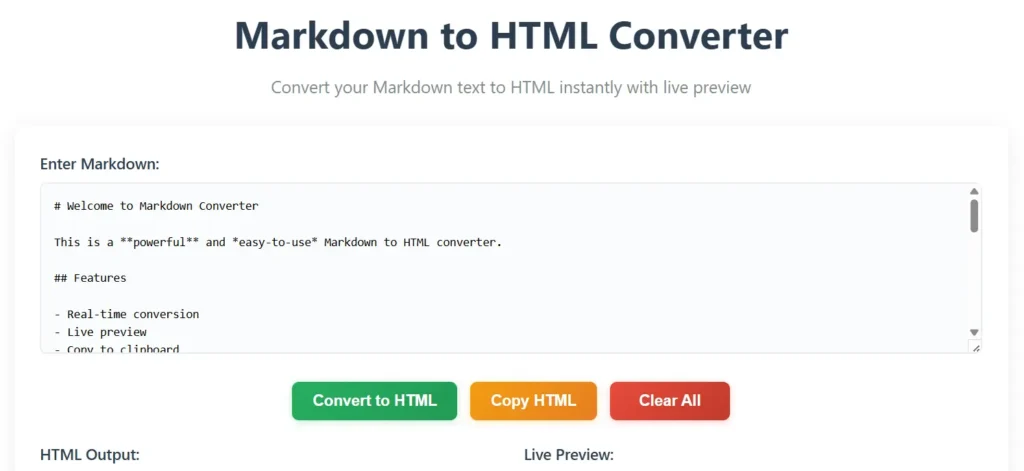If you’re writing blog posts, documentation, or web content in Markdown, you’re not alone. Markdown has become the go-to markup language for developers, bloggers, and technical writers. It’s lightweight, easy to read, and focuses on writing instead of formatting.
But when it’s time to publish, Markdown alone isn’t enough.
To get your content live on the web—especially if you’re using a CMS or static site—you need to convert Markdown to HTML. In this guide, we’ll walk you through exactly how to do that using simple tools, coding methods, and automation—no matter your technical skill level.
Whether you’re a beginner starting a blog or a developer managing multiple pages, this post will teach you how to handle Markdown-to-HTML conversion with ease.
What Is Markdown and Why Is It So Popular?
Markdown: The Language of Minimalist Writing
Markdown is a lightweight markup language that allows you to write formatted text using plain text syntax. It was created by John Gruber in 2004 to make it easy to write web content that could be converted into clean HTML.
Instead of using tags like <h1> or <strong>, Markdown uses simpler symbols like # for headers or **bold** for emphasis. It’s readable, fast, and doesn’t distract you from your thoughts.
Where Is Markdown Commonly Used?
- Blog posts (e.g., Ghost, Jekyll, Hugo)
- GitHub README files
- API documentation
- Technical notes
- Static site generators
Why Content Creators Love Markdown
- Fast writing experience
- Minimal syntax to learn
- Easy to version control (especially with Git)
- Cleaner than raw HTML for drafting
For example:
markdownCopyEdit# Hello World
This is **bold** and this is *italic*.
Becomes:
htmlCopyEdit<h1>Hello World</h1>
<p>This is <strong>bold</strong> and this is <em>italic</em>.</p>
But you still need to convert it properly for the web. That’s what the next sections cover.
Why Convert Markdown to HTML?
While Markdown is great for writing, it has limitations:
- Not all blogging platforms or CMSs support raw
.mdfiles - You can’t apply advanced styling, scripting, or custom layout with Markdown alone
- You need HTML to fully control presentation on websites
In short, Markdown is for writing, but HTML is for publishing.
Whether you’re using WordPress, Blogger, or custom CMS, converting Markdown to HTML ensures your content is compatible and beautifully rendered.
Methods to Convert Markdown to HTML
There are several ways to convert Markdown into clean, readable HTML. Let’s explore the most effective ones based on your skill level and needs.
A. Use an Online Markdown to HTML Converter
For most users, this is the fastest and easiest method.
Step-by-Step:
- Open a free converter like MarkdownToHTML.com
- Paste your Markdown text into the input box
- Instantly see the converted HTML on the right
- Click Copy HTML or download it
- Paste it into your website editor, WordPress, or static site
Best For:
- Bloggers
- Content writers
- Students and non-developers
Pro Tip:
You can also clean the output HTML using our Text Cleaner Tool on DownloadDaisy.
B. Use JavaScript or Python Libraries (for Developers)
If you’re working on a custom blog engine or CMS, or need to automate conversions, libraries are perfect.
JavaScript Example (with marked.js):
javascriptCopyEditconst marked = require("marked");
const markdown = "# Hello World";
const html = marked(markdown);
console.log(html);
You can integrate this in any Node.js-based project or browser interface.
Python Example (using markdown library):
pythonCopyEditimport markdown
with open("example.md", "r") as f:
text = f.read()
html = markdown.markdown(text)
print(html)
Install the module with:
bashCopyEditpip install markdown
Best For:
- Developers
- Tech-savvy bloggers
- Backend automation
C. Use Command Line Tools (e.g., Pandoc)
Pandoc is one of the most powerful tools for document conversion.
Convert Markdown to HTML:
bashCopyEditpandoc input.md -f markdown -t html5 -o output.html
You can even batch process entire folders with a script.
Best For:
- Developers with lots of files
- Academics creating documentation
- Linux or terminal users
Convert Markdown to HTML for Your Blog
Let’s say you’re writing a blog post using Markdown on your local machine. Here’s how you’d convert it to HTML and publish it.
Choose a Tool
- Beginner? Use MarkdownToHTML.com
- Developer? Use
marked.js,markdown(Python), orPandoc
Convert Your Markdown
Paste the content into the tool, or run a script, depending on your method.
Copy or Download the HTML
Take the converted HTML and paste it into your blog’s code editor or CMS.
Style It (Optional)
Add classes or link your CSS stylesheet to make the content match your site’s design.
Preview and Publish
Always preview the blog post to ensure proper formatting before making it public.
Best Practices for Markdown to HTML Conversion
Keep Your Markdown Clean
Use consistent formatting, avoid mixing syntax styles, and always test with a preview.
Use Headings Properly
Always follow a hierarchy:
#for H1 (used only once)##for H2###for H3
This improves both SEO and readability.
Avoid Inline HTML (if you can)
While Markdown lets you embed raw HTML, it defeats the purpose of clean writing. Only use HTML when necessary.
Automate When Scaling
If you manage many blog posts, automate the conversion using tools like Python scripts or Node.js modules.
Frequently Asked Questions (FAQ)
What’s the difference between Markdown and HTML?
Markdown is simpler and designed for writing, while HTML is more powerful and controls webpage layout.
Can I convert HTML back to Markdown?
Yes, tools like Pandoc and html-to-md libraries allow reverse conversion, but it may not always be perfect.
Are there any risks with online converters?
Most are safe, but avoid uploading sensitive content. Stick to trusted converters or open-source libraries.
Can I customize the HTML output?
Yes! After conversion, you can style the output using CSS, or even wrap it in your blog’s custom HTML templates.
What’s the easiest way to convert Markdown to HTML?
Use a free online Markdown to HTML converter like our Markdown to HTML Tool. It’s instant, no signup, and works in your browser.
Conclusion: Markdown for Writing, HTML for Publishing
If you’re writing your content in Markdown, you’re already one step ahead in productivity. But to publish professionally on a blog or website, converting Markdown to HTML is essential.
From free online converters to developer automation with Python or Pandoc, the process is easy—and scalable.
Whether you’re a writer, student, developer, or technical marketer, take the next step:
Write in Markdown
Convert to HTML
Publish with confidence
Try our free Markdown to HTML Converter Tool on DownloadDaisy and simplify your blogging workflow today.

